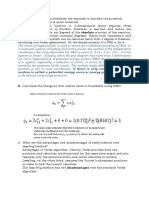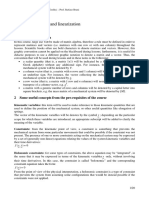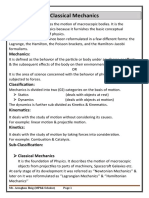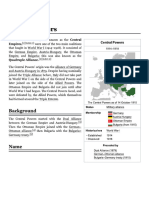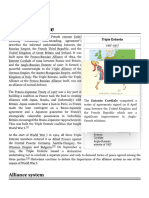Degrees of Freedom (Physics and Chemistry) - Wikipedia, The Free Encyclopedia
Degrees of Freedom (Physics and Chemistry) - Wikipedia, The Free Encyclopedia
Uploaded by
bmxengineeringCopyright:
Available Formats
Degrees of Freedom (Physics and Chemistry) - Wikipedia, The Free Encyclopedia
Degrees of Freedom (Physics and Chemistry) - Wikipedia, The Free Encyclopedia
Uploaded by
bmxengineeringOriginal Description:
Copyright
Available Formats
Share this document
Did you find this document useful?
Is this content inappropriate?
Copyright:
Available Formats
Degrees of Freedom (Physics and Chemistry) - Wikipedia, The Free Encyclopedia
Degrees of Freedom (Physics and Chemistry) - Wikipedia, The Free Encyclopedia
Uploaded by
bmxengineeringCopyright:
Available Formats
From Wikipedia, the free encyclopedia
In physics, a degree of freedom is an independent physical parameter in the formal description of the state of a
physical system. The set of all dimensions of a system is known as a phase space, and degrees of freedom are
sometimes referred to as its dimensions.
1 Definition
2 Degrees of freedom of gas molecules
3 Independent degrees of freedom
3.1 Demonstrations
4 Quadratic degrees of freedom
4.1 Quadratic and independent degree of freedom
4.2 Equipartition theorem
5 Generalizations
6 References
A degree of freedom of a physical system refers to a (typically real) parameter that is necessary to characterize
the state of a physical system.
Consider a point particle that is free to move in three dimensions. The location of any particle in three-
dimensional space can be specified by three position coordinates: x, y, and z. The direction and speed at which
a particle moves can be described in terms of three velocity components, e.g. v
x
, v
y
, and v
z
. If the time
evolution of the system is deterministic, where the state at one instant uniquely determines its past and future
position and velocity as a function of time, such a system will have six degrees of freedom. If the motion of the
particle is constrained to a lower number of dimensions if, for example, the particle must move along a wire
or on a fixed surface then the system will have less than six degrees of freedom. On the other hand, a system
with an extended object that may rotate or vibrate can have more than six degrees of freedom. A force on the
particle that depends only upon time and the particle's position and velocity fits this description.
In mechanics, a point particle's state at any given time can be described with position and velocity coordinates
in the Lagrangian formalism, or with position and momentum coordinates in the Hamiltonian formalism.
Similarly, in statistical mechanics, a degree of freedom is a single scalar number describing the microstate of a
system.
[1]
The specification of all microstates of a system is a point in the system's phase space.
A degree of freedom may be any useful property that is not dependent on other variables. For example, in the
3D ideal chain model, two angles are necessary to describe each monomer's orientation.
Degrees of freedom (physics and chemistry) - Wikipedia, the free encycl... http://en.wikipedia.org/wiki/Degrees_of_freedom_(physics_and_chemistry)
1 of 6 7/22/2014 1:53 AM
Different ways of visualizing the 6
degrees of freedom of a diatomic
molecule. (CM: center of mass of the
system, T: translational motion, R:
rotational motion, V: vibrational
motion.)
In statistical mechanics and thermodynamics, it is often useful to specify quadratic degrees of freedom. These
are degrees of freedom that contribute in a quadratic way to the energy of the system. They are also variables
that contribute quadratically to the Hamiltonian.
In three-dimensional space, three degrees of freedom are associated with
the movement of a particle. A diatomic gas molecule thus has 6 degrees
of freedom. This set may be decomposed in terms of translations,
rotations, and vibrations of the molecule. The center of mass motion of
the entire molecule accounts for 3 degrees of freedom. In addition, the
molecule has two rotational degrees of motion and one vibrational mode.
The rotations occur around the two axes perpendicular to the line
between the two atoms. The rotation around the atomatom bond is not a
physical rotation. This yields, for a diatomic molecule, a decomposition
of:
For a general (non-linear) molecule with N > 2 atoms, all 3 rotational
degrees of freedom are considered, resulting in the decomposition:
which means that an N-atom molecule has 3N 6 vibrational degrees
of freedom for N > 2. In special cases, such as adsorbed large molecules, the rotational degrees of freedom can
be limited to only one.
[2]
As defined above one can also count degrees of freedom using the minimum number of coordinates required to
specify a position. This is done as follows:
For a single particle we need 2 coordinates in a 2-D plane to specify its position and 3 coordinates in 3-D
plane. Thus its degree of freedom in a 3-D plane is 3.
1.
For a body consisting of 2 particles (ex. a diatomic molecule) in a 3-D plane with constant distance
between them (let's say d) we can show (below) its degrees of freedom to be 5.
2.
Let's say one particle in this body has coordinate (x
1
,y
1
,z
1
) and the other has coordinate (x
2
,y
2
,z
2
) with z
2
unknown. Application of the formula for distance between two coordinates
results in one equation with one unknown, in which we can solve for z
2
. One of x
1
, x
2
, y
1
, y
2
, z
1
, or z
2
can be
unknown.
Contrary to the classical equipartition theorem, at room temperature, the vibrational motion of molecules
Degrees of freedom (physics and chemistry) - Wikipedia, the free encycl... http://en.wikipedia.org/wiki/Degrees_of_freedom_(physics_and_chemistry)
2 of 6 7/22/2014 1:53 AM
typically makes negligible contributions to the heat capacity. This is because these degrees of freedom are
frozen because the spacing between the energy eigenvalues exceeds the energy corresponding to ambient
temperatures (k
B
T). In the following table such degrees of freedom are disregarded because of their low effect
on total energy. However, at very high temperatures they cannot be neglected.
Monatomic Linear molecules Non-linear molecules
Translation (x, y, and z) 3 3 3
Rotation (x, y, and z) 0 2 3
Vibration 0 3N 5 3N 6
Total 3 3N 3N
The set of degrees of freedom X
1
,,X
N
of a system is independent if the energy associated with the set can
be written in the following form:
where E
i
is a function of the sole variable X
i
.
example: if X
1
and X
2
are two degrees of freedom, and E is the associated energy:
If , then the two degrees of freedom are independent.
If , then the two degrees of freedom are not independent. The term
involving the product of X
1
and X
2
is a coupling term, that describes an interaction between the
two degrees of freedom.
At thermodynamic equilibrium, X
1
,,X
N
are all statistically independent of each other.
For i from 1 to N, the value of the ith degree of freedom X
i
is distributed according to the Boltzmann
distribution. Its probability density function is the following:
,
In this section, and throughout the article the brackets denote the mean of the quantity they enclose.
The internal energy of the system is the sum of the average energies associated to each of the degrees of
Degrees of freedom (physics and chemistry) - Wikipedia, the free encycl... http://en.wikipedia.org/wiki/Degrees_of_freedom_(physics_and_chemistry)
3 of 6 7/22/2014 1:53 AM
freedom:
Demonstrations
A system exchanges energy in the form of heat with its surroundings and the number of particles in the system
remains fixed. This corresponds to studying the system in the canonical ensemble. Note that in statistical
mechanics, a result that is demonstrated for a system in a particular ensemble remains true for this system at the
thermodynamic limit in any ensemble. In the canonical ensemble, at thermodynamic equilibrium, the state of
the system is distributed among all micro-states according to the Boltzmann distribution. If T is the system's
temperature and k
B
is Boltzmann's constant, then the probability density function associated to each micro-state
is the following:
,
The denominator in the above expression plays an important role.
[3]
This expression immediately breaks down
into a product of terms depending of a single degree of freedom:
The existence of such a breakdown of the multidimensional probability density function into a product of
functions of one variable is enough by itself to demonstrate that X
1
,,X
N
are statistically independent from
each other.
Since each function p
i
is normalized, it follows immediately that p
i
is the probability density function of the
degree of freedom X
i
, for i from 1 to N.
Finally, the internal energy of the system is its mean energy. The energy of a degree of freedom E
i
is a function
of the sole variable X
i
. Since X
1
,,X
N
are independent from each other, the energies E
1
(X
1
),,E
N
(X
N
)
are also statistically independent from each other. The total internal energy of the system can thus be written as:
A degree of freedom X
i
is quadratic if the energy terms associated to this degree of freedom can be written as
,
Degrees of freedom (physics and chemistry) - Wikipedia, the free encycl... http://en.wikipedia.org/wiki/Degrees_of_freedom_(physics_and_chemistry)
4 of 6 7/22/2014 1:53 AM
where Y is a linear combination of other quadratic degrees of freedom.
example: if X
1
and X
2
are two degrees of freedom, and E is the associated energy:
If , then the two degrees of freedom are not independent and
non-quadratic.
If , then the two degrees of freedom are independent and non-quadratic.
If , then the two degrees of freedom are not independent but are
quadratic.
If , then the two degrees of freedom are independent and quadratic.
For example, in Newtonian mechanics, the dynamics of a system of quadratic degrees of freedom are controlled
by a set of homogeneous linear differential equations with constant coefficients.
Quadratic and independent degree of freedom
X
1
,,X
N
are quadratic and independent degrees of freedom if the energy associated to a microstate of the
system they represent can be written as:
Equipartition theorem
In the classical limit of statistical mechanics, at thermodynamic equilibrium, the internal energy of a system of
N quadratic and independent degrees of freedom is:
Here, the mean energy associated with a degree of freedom is:
Since the degrees of freedom are independent, the internal energy of the system is equal to the sum of the mean
energy associated with each degree of freedom, which demonstrates the result.
Degrees of freedom (physics and chemistry) - Wikipedia, the free encycl... http://en.wikipedia.org/wiki/Degrees_of_freedom_(physics_and_chemistry)
5 of 6 7/22/2014 1:53 AM
The description of a system's state as a point in its phase space, although mathematically convenient, is thought
to be fundamentally inaccurate. In quantum mechanics, the motion degrees of freedom are superseded with the
concept of wave function, and operators which correspond to other degrees of freedom have discrete spectra.
For example, intrinsic angular momentum operator (which corresponds to the rotational freedom) for an
electron or photon have only two eigenvalues, and a continuous rotational freedom of classical bodies becomes
reduced to so named spin for these and other microscopic particles. This effect of discreteness (sometimes
referred to as quantization, although the latter is a much broader concept) becomes dominant when action has
an order of magnitude of the Planck constant, and individual degrees of freedom cannot be distinguished then.
^ Reif, F. (2009). Fundamentals of Statistical and Thermal Physics. Long Grove, IL: Waveland Press, Inc. p. 51.
ISBN 1-57766-612-7.
1.
^ Thomas Waldmann, Jens Klein, Harry E. Hoster, R. Jrgen Behm (2012), "Stabilization of Large Adsorbates by
Rotational Entropy: A Time-Resolved Variable-Temperature STM Study" (in German), ChemPhysChem: pp. n/an/a,
doi:10.1002/cphc.201200531 (http://dx.doi.org/10.1002%2Fcphc.201200531)
2.
^ "Configuration integral (statistical mechanics)" (http://clesm.mae.ufl.edu/wiki.pub/index.php
/Configuration_integral_%28statistical_mechanics%29#Thermodynamic_properties).
3.
Retrieved from "http://en.wikipedia.org/w/index.php?title=Degrees_of_freedom_(physics_and_chemistry)&
oldid=616668430"
Categories: Concepts in physics Dimension
This page was last modified on 12 July 2014 at 16:19.
Text is available under the Creative Commons Attribution-ShareAlike License; additional terms may
apply. By using this site, you agree to the Terms of Use and Privacy Policy. Wikipedia is a registered
trademark of the Wikimedia Foundation, Inc., a non-profit organization.
Degrees of freedom (physics and chemistry) - Wikipedia, the free encycl... http://en.wikipedia.org/wiki/Degrees_of_freedom_(physics_and_chemistry)
6 of 6 7/22/2014 1:53 AM
You might also like
- StatisticalPhysics Part1 HandoutDocument27 pagesStatisticalPhysics Part1 HandoutMauro LaraNo ratings yet
- Religion Research Paper OutlineDocument2 pagesReligion Research Paper Outlinelady.nyxyNo ratings yet
- Degrees of Freedom (Physics and Chemistry)Document4 pagesDegrees of Freedom (Physics and Chemistry)el_koptan00857693No ratings yet
- Degree of Freedom 2k20-ME-25Document4 pagesDegree of Freedom 2k20-ME-25burhan644ahmadNo ratings yet
- Stmech RevDocument28 pagesStmech RevmerciermcNo ratings yet
- Statistical PhysicsDocument24 pagesStatistical PhysicsokeykanNo ratings yet
- MSC Maths Optional Paper VDocument185 pagesMSC Maths Optional Paper VSaad KhanNo ratings yet
- 2 Statistical Description of SystemsDocument51 pages2 Statistical Description of SystemsSebastian mdalahelaNo ratings yet
- PPS Project ReportDocument7 pagesPPS Project ReportRITIK JAINNo ratings yet
- Degrees of FreedomDocument6 pagesDegrees of FreedomMd MarufNo ratings yet
- Applications of Symmetry and Group Theory (Artigo)Document22 pagesApplications of Symmetry and Group Theory (Artigo)MoahVieiraNo ratings yet
- Lagrange Equation 1Document32 pagesLagrange Equation 1Gthulasi78No ratings yet
- Gaskin MechanicsDocument47 pagesGaskin MechanicsLia MewwNo ratings yet
- The Purpose of Statistical MechanicsDocument9 pagesThe Purpose of Statistical Mechanicswill2222No ratings yet
- Elastic Collision - WikipediaDocument49 pagesElastic Collision - Wikipediawkagar17No ratings yet
- New Microsoft Word DocumentDocument2 pagesNew Microsoft Word Documenthmedhichri02No ratings yet
- Thermo 0 PDFDocument12 pagesThermo 0 PDFandieysNo ratings yet
- Two-Degree-of-Freedom SystemsDocument19 pagesTwo-Degree-of-Freedom SystemsMarwan NasserNo ratings yet
- Dynamics of System of ParticlesDocument5 pagesDynamics of System of ParticlesTrilok AkhaniNo ratings yet
- 8.044 Statistical Physics I: Mit OpencoursewareDocument70 pages8.044 Statistical Physics I: Mit OpencoursewareFederico SecondiNo ratings yet
- Quantum Number: How Many Quantum Numbers?Document6 pagesQuantum Number: How Many Quantum Numbers?kakulitan93No ratings yet
- Chapter 1Document14 pagesChapter 1Rena RichNo ratings yet
- Physics IIDocument76 pagesPhysics IINaresh KumarNo ratings yet
- Test Sets For 2019 AprilDocument15 pagesTest Sets For 2019 AprilnishuNo ratings yet
- Thermodynamics Lecture 1Document27 pagesThermodynamics Lecture 1JaevncsoNo ratings yet
- Lagrangian MechanicsDocument15 pagesLagrangian Mechanicsrr1819100% (1)
- Classical Mechanics-Pdf by Dr. Rajesh MathpalDocument45 pagesClassical Mechanics-Pdf by Dr. Rajesh MathpalMunna MunendharNo ratings yet
- Stavros C. Farantos - Non-Linear Vibrational Normal Modes of BiomoleculesDocument7 pagesStavros C. Farantos - Non-Linear Vibrational Normal Modes of BiomoleculesMaxnamewNo ratings yet
- Stat Therm 1Document23 pagesStat Therm 1AhmadNo ratings yet
- FEM Theory AnswersDocument45 pagesFEM Theory Answerskhushendrafule14No ratings yet
- Two Body, Central-Force ProblemDocument15 pagesTwo Body, Central-Force ProblemAvnish GargNo ratings yet
- Mechanical Vibration of Multiple Degrees of Freedom SystemsDocument5 pagesMechanical Vibration of Multiple Degrees of Freedom SystemsChristopher YsitNo ratings yet
- Legrangian FormalismDocument12 pagesLegrangian FormalismSreelakshmi AnilNo ratings yet
- Poly-Thermo-Smpc1-2223 enDocument47 pagesPoly-Thermo-Smpc1-2223 enmajaraemi2023No ratings yet
- General Physics I Essay by Farid MammadovDocument24 pagesGeneral Physics I Essay by Farid MammadovФарид МамедовNo ratings yet
- Ch1 Asm REVSM NptelDocument19 pagesCh1 Asm REVSM NptelRajat KumarNo ratings yet
- Basic of VibrationDocument57 pagesBasic of Vibrationaprabhakar15No ratings yet
- Normal Modes TextDocument13 pagesNormal Modes TextVie YaNo ratings yet
- BTCEIU20075 - Tống Nguyễn Ngọc ThanhDocument5 pagesBTCEIU20075 - Tống Nguyễn Ngọc ThanhThanh TongNo ratings yet
- Analytical MechanicsDocument2 pagesAnalytical MechanicsVamsi SrinivasanNo ratings yet
- Statistical Mechanics Viva QuestionsDocument4 pagesStatistical Mechanics Viva QuestionsThanveer Hussain ThanuNo ratings yet
- b.sc-iII (Paper-1) Unit-II-statistical Physics-i-By Dr. Anand Kumar DwivediDocument10 pagesb.sc-iII (Paper-1) Unit-II-statistical Physics-i-By Dr. Anand Kumar DwivediDipankar AdhikaryNo ratings yet
- Lecture 4. Macrostates and Microstates (Ch. 2) : Processes Are Not Inevitable, They Are Just Overwhelmingly ProbableDocument21 pagesLecture 4. Macrostates and Microstates (Ch. 2) : Processes Are Not Inevitable, They Are Just Overwhelmingly ProbablePreethi KesavanNo ratings yet
- Chapter 2 - SDOFDocument13 pagesChapter 2 - SDOFUlrich Simo DomguiaNo ratings yet
- Non Linear System and LinearizationDocument20 pagesNon Linear System and LinearizationGianluca MustilloNo ratings yet
- Classical MechanicsDocument3 pagesClassical MechanicsMr. BaiGNo ratings yet
- Physics ReviewDocument361 pagesPhysics ReviewPavan BoroNo ratings yet
- Two DegreeDocument17 pagesTwo DegreeAmanuelNo ratings yet
- Thermal Physics Lecture 13Document7 pagesThermal Physics Lecture 13OmegaUserNo ratings yet
- Quantum Spin System: 1 GradingDocument4 pagesQuantum Spin System: 1 GradingSouzaSantosNo ratings yet
- TD Basic ConceptsDocument60 pagesTD Basic ConceptsSK.FARAZ HUSSAINNo ratings yet
- Principle And: D'Alembert's Lagrange's EquationsDocument9 pagesPrinciple And: D'Alembert's Lagrange's Equationsabel.aryanghoshNo ratings yet
- MCE312 (Module 1)Document32 pagesMCE312 (Module 1)Muiruri JacobNo ratings yet
- 1 Classical MechanicsDocument11 pages1 Classical MechanicsJayant MukherjeeNo ratings yet
- Systems of Particles: Physics 53Document8 pagesSystems of Particles: Physics 53Okan ÜlgenNo ratings yet
- What Is Statistical Mechanics?: Roman FriggDocument27 pagesWhat Is Statistical Mechanics?: Roman FriggDiego SaraviaNo ratings yet
- AT - Unit 4Document56 pagesAT - Unit 4mayilNo ratings yet
- Analyt MechanicsDocument14 pagesAnalyt MechanicsAlfredo RomeroNo ratings yet
- CentralDocument29 pagesCentralbmxengineeringNo ratings yet
- CoalitionDocument6 pagesCoalitionbmxengineeringNo ratings yet
- EntenteDocument7 pagesEntentebmxengineeringNo ratings yet
- AiscDocument4 pagesAiscbmxengineeringNo ratings yet
- New South Wales 82 Class Locomotive - Wikipedia, The Free EncyclopediaDocument2 pagesNew South Wales 82 Class Locomotive - Wikipedia, The Free EncyclopediabmxengineeringNo ratings yet
- Clyde Engineering - Wikipedia, The Free EncyclopediaDocument6 pagesClyde Engineering - Wikipedia, The Free EncyclopediabmxengineeringNo ratings yet
- Richard Bronson - Wikipedia, The Free EncyclopediaDocument5 pagesRichard Bronson - Wikipedia, The Free EncyclopediabmxengineeringNo ratings yet
- Christopher Chenery - Wikipedia, The Free EncyclopediaDocument3 pagesChristopher Chenery - Wikipedia, The Free EncyclopediabmxengineeringNo ratings yet
- Roger Blaine Porter (Born 19 June 1946) Is An American: From Wikipedia, The Free EncyclopediaDocument3 pagesRoger Blaine Porter (Born 19 June 1946) Is An American: From Wikipedia, The Free EncyclopediabmxengineeringNo ratings yet
- Geochemistry - Wikipedia, The Free EncyclopediaDocument6 pagesGeochemistry - Wikipedia, The Free EncyclopediabmxengineeringNo ratings yet
- Shot Put - Wikipedia, The Free EncyclopediaDocument13 pagesShot Put - Wikipedia, The Free EncyclopediabmxengineeringNo ratings yet
- Shot Put - Wikipedia, The Free EncyclopediaDocument13 pagesShot Put - Wikipedia, The Free EncyclopediabmxengineeringNo ratings yet
- Hollis BDocument3 pagesHollis BbmxengineeringNo ratings yet
- Christopher Chenery - Wikipedia, The Free EncyclopediaDocument3 pagesChristopher Chenery - Wikipedia, The Free EncyclopediabmxengineeringNo ratings yet
- Semolina - Wikipedia, The Free EncyclopediaDocument4 pagesSemolina - Wikipedia, The Free EncyclopediabmxengineeringNo ratings yet
- Stéphane Grappelli - Wikipedia, The Free EncyclopediaDocument8 pagesStéphane Grappelli - Wikipedia, The Free EncyclopediabmxengineeringNo ratings yet
- Anne Osborn Krueger - Wikipedia, The Free EncyclopediaDocument3 pagesAnne Osborn Krueger - Wikipedia, The Free EncyclopediabmxengineeringNo ratings yet
- Air-Raid Shelter - Wikipedia, The Free EncyclopediaDocument15 pagesAir-Raid Shelter - Wikipedia, The Free EncyclopediabmxengineeringNo ratings yet
- Semolina - Wikipedia, The Free EncyclopediaDocument4 pagesSemolina - Wikipedia, The Free EncyclopediabmxengineeringNo ratings yet
- Wheat - Wikipedia, The Free EncyclopediaDocument19 pagesWheat - Wikipedia, The Free EncyclopediabmxengineeringNo ratings yet
- Sociolinguistics Paper Bilingualism and Multilingualism in The SocietyDocument12 pagesSociolinguistics Paper Bilingualism and Multilingualism in The SocietynursaidaNo ratings yet
- Bani ScribdDocument100 pagesBani ScribdGheras IonNo ratings yet
- Review of The Use of The Balanced Scorecard in Healthcare BMCDDocument38 pagesReview of The Use of The Balanced Scorecard in Healthcare BMCDmalatebusNo ratings yet
- Kirinyaga County Public Service BoardDocument2 pagesKirinyaga County Public Service BoardGovernor Joseph NdathiNo ratings yet
- Hooke's Law - WikipediaDocument17 pagesHooke's Law - WikipediaYtyus BlackNo ratings yet
- Panentheism and Hindu Tantra, Abhinavagupta's Grammatical Cosmology-Loriliai BiernackiDocument26 pagesPanentheism and Hindu Tantra, Abhinavagupta's Grammatical Cosmology-Loriliai Biernackiitineo2012No ratings yet
- J.S MillDocument6 pagesJ.S MillRana Umar HayyatNo ratings yet
- Letters From Sigmund Freud To Wilhelm ReichDocument12 pagesLetters From Sigmund Freud To Wilhelm ReichfbnfranciscoNo ratings yet
- (Warren, 1916) The Role of Purpose in NatureDocument17 pages(Warren, 1916) The Role of Purpose in NatureBernardoNo ratings yet
- Production: Putting Words in One's Mouth 8 Production: Putting Words in One's MouthDocument7 pagesProduction: Putting Words in One's Mouth 8 Production: Putting Words in One's MouthJermias Mateus NhamigareNo ratings yet
- CMC Mathazine: VOLUME 1 - October 2020 ISSUEDocument52 pagesCMC Mathazine: VOLUME 1 - October 2020 ISSUEBijli BegumNo ratings yet
- S11 12ES Ia e 2Document2 pagesS11 12ES Ia e 2Erica De Guzman AngelesNo ratings yet
- Introduction To Phenomenological Psychological Research: KarlssonDocument13 pagesIntroduction To Phenomenological Psychological Research: KarlssonmacNo ratings yet
- Determinants of Consumer Engagement in Electronic Word-Of-Mouth (eWOM) in Social Networking SitesDocument30 pagesDeterminants of Consumer Engagement in Electronic Word-Of-Mouth (eWOM) in Social Networking SitesdanikapanNo ratings yet
- Fluid Dispersion-Generalization and Comparison of Mathematical Models-I Generalization of ModelsDocument11 pagesFluid Dispersion-Generalization and Comparison of Mathematical Models-I Generalization of ModelsJesus Moreno CastilloNo ratings yet
- perdev2-WPS OfficeDocument4 pagesperdev2-WPS OfficeKaren Vanessa Magada MendozaNo ratings yet
- Transformative Learning TheoryDocument8 pagesTransformative Learning Theoryapi-747278862No ratings yet
- Leader's DigestDocument6 pagesLeader's DigestAbi GailNo ratings yet
- DISS - Lesson 5 - Dominant Approaches and Ideas in Social SciencesDocument33 pagesDISS - Lesson 5 - Dominant Approaches and Ideas in Social SciencesMary Joy Dailo86% (22)
- The Physics of Time Travel (Michio Kaku)Document2 pagesThe Physics of Time Travel (Michio Kaku)Sol AmorteguiNo ratings yet
- Compare and Contrast ReflectionDocument3 pagesCompare and Contrast Reflectionapi-290076952No ratings yet
- (Research and Practice in Applied Linguistics) Martha C. Pennington, Pamela Rogerson-Revell - English Pronunciation Teaching and Research - Contemporary Perspectives-Palgrave Macmillan UK (2019)Document510 pages(Research and Practice in Applied Linguistics) Martha C. Pennington, Pamela Rogerson-Revell - English Pronunciation Teaching and Research - Contemporary Perspectives-Palgrave Macmillan UK (2019)Joao Manoel100% (1)
- Reading 123Document4 pagesReading 123Manpreet SinghNo ratings yet
- What Does This Reveal About Lady Macbeth?Document1 pageWhat Does This Reveal About Lady Macbeth?WitchingDread10No ratings yet
- se'iJII'f'Y.: 178 Theories of Women'S Subordination One Is Not Born A Woman 179Document3 pagesse'iJII'f'Y.: 178 Theories of Women'S Subordination One Is Not Born A Woman 179Maira RodriguezNo ratings yet
- Arrowsmith Program BrochureDocument24 pagesArrowsmith Program BrochureMSHYDERABAD4334100% (1)
- Revelation Explained at LastDocument24 pagesRevelation Explained at LastPamela CarbungcoNo ratings yet
- Unit 1 The Victorian Age Structure:: TH THDocument11 pagesUnit 1 The Victorian Age Structure:: TH THTeeba RoseNo ratings yet
- Artificial IntelligenceDocument2 pagesArtificial IntelligenceTwinkle GarttanNo ratings yet























